Serving 561 students in grades 9-12, Juneau-douglas High School Yadaa.at Kale ranks in the top 30% of all schools in Alaska for overall test scores (math proficiency is top 30%, and reading proficiency is top 30%).
The percentage of students achieving proficiency in math is 35-39% (which is higher than the Alaska state average of 23%). The percentage of students achieving proficiency in reading/language arts is 40-44% (which is higher than the Alaska state average of 29%).
The student:teacher ratio of 19:1 is higher than the Alaska state level of 15:1.
Minority enrollment is 53% of the student body (majority American Indian and Asian), which is equal to the Alaska state average of 53% (majority American Indian).
Quick Stats (2025)
- Grades: 9-12
- Enrollment: 561 students
- Student:Teacher Ratio: 19:1
- Minority Enrollment: 53%
- Graduation Rate: 85-89% (Top 20% in AK)
- Overall Testing Rank: Top 30%
- Math Proficiency: 35-39% (Top 30%)
- Reading Proficiency: 40-44% (Top 50%)
- Science Proficiency: 50-54% (Top 30%)
- Source: National Center for Education Statistics (NCES), AK Dept. of Education
Top Rankings
Juneau-douglas High School Yadaa.at Kale ranks among the top 20% of public schools in Alaska for:
Category
Attribute
Most improved public schools
Graduation Rate
Diversity
School Overview
Juneau-douglas High School Yadaa.at Kale's student population of 561 students has declined by 7% over five school years.
The teacher population of 30 teachers has stayed relatively flat over five school years.
Grades Offered
Grades 9-12
(offers virtual instruction)
(offers virtual instruction)
Total Students
561 students
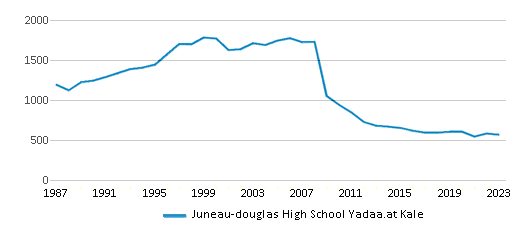
Gender %
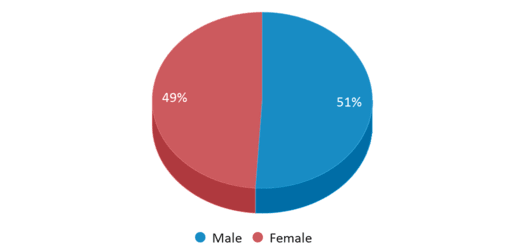
Total Classroom Teachers
30 teachers

Students by Grade
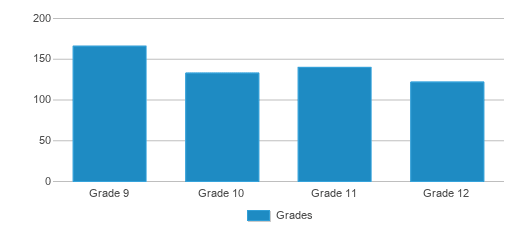
School Calendar
School Rankings
Juneau-douglas High School Yadaa.at Kale ranks within the top 30% of all 459 schools in Alaska (based off of combined math and reading proficiency testing data).
The diversity score of Juneau-douglas High School Yadaa.at Kale is 0.72, which is more than the diversity score at state average of 0.71. The school's diversity has stayed relatively flat over five school years.
Overall Testing Rank
#132 out of 459 schools
(Top 30%)
(Top 30%)
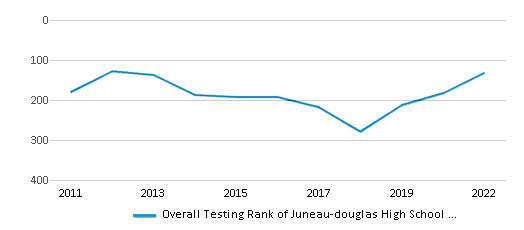
Math Test Scores (% Proficient)
35-39%
23%
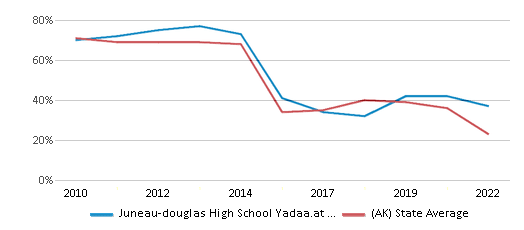
Reading/Language Arts Test Scores (% Proficient)
40-44%
29%
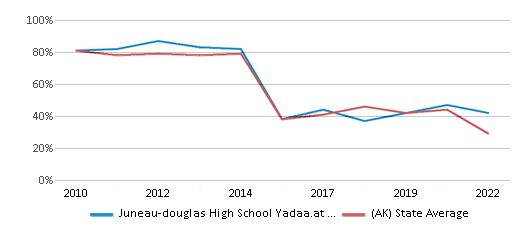
Science Test Scores (% Proficient)
50-54%
38%
Student : Teacher Ratio
19:1
15:1
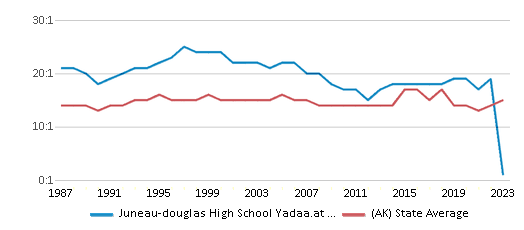
American Indian
10%
22%
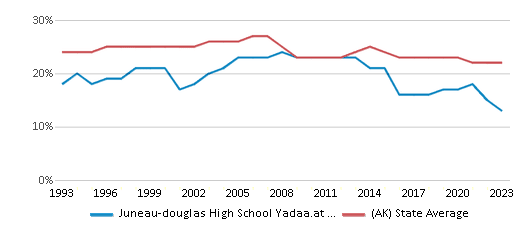
Asian
9%
5%
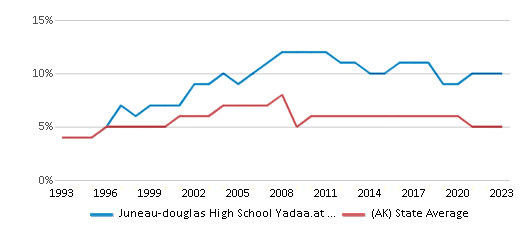
Hispanic
9%
8%
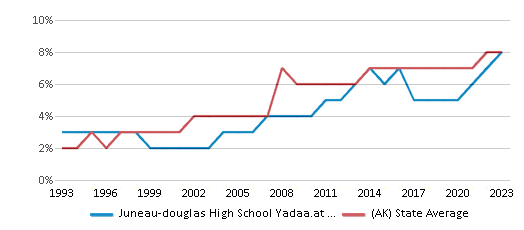
Black
2%
2%
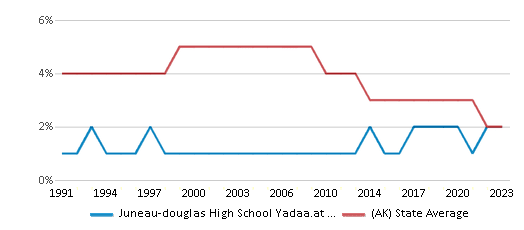
White
47%
47%
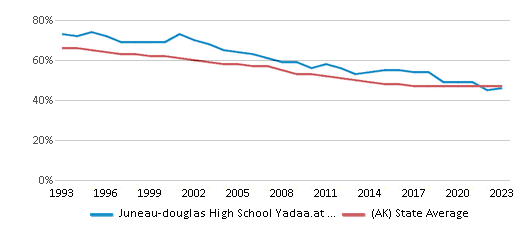
Hawaiian
3%
3%
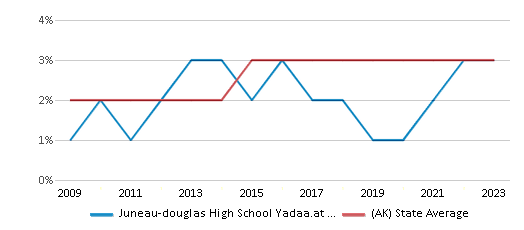
Two or more races
20%
13%
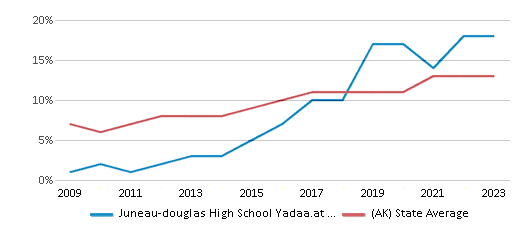
All Ethnic Groups


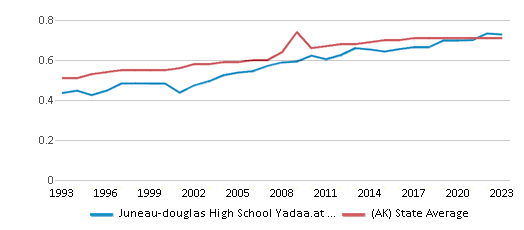
Graduation Rate
85-89%
78%

Participates in the National School Lunch Program (NSLP)
Yes
Eligible for Free Lunch
14%
37%
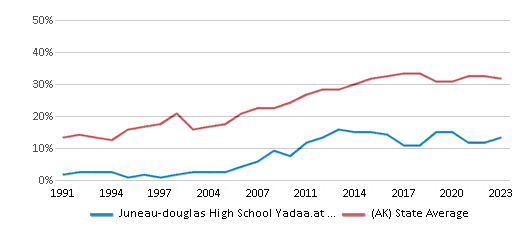
Eligible for Reduced Lunch
4%
3%
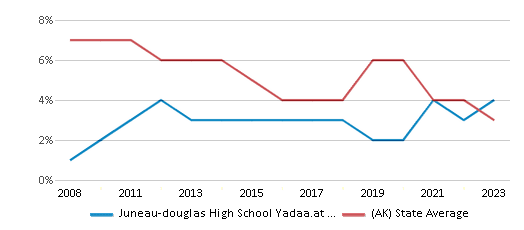
School Statewide Testing
School District Name
Source: National Center for Education Statistics (NCES), AK Dept. of Education
Profile last updated:
Frequently Asked Questions
What is Juneau-douglas High School Yadaa.at Kale's ranking?
Juneau-douglas High School Yadaa.at Kale is ranked #132 out of 459 schools, which ranks it among the top 30% of public schools in Alaska.
What schools are Juneau-douglas High School Yadaa.at Kale often compared to?
Juneau-douglas High School Yadaa.at Kaleis often viewed alongside schools like Thunder Mountain High School by visitors of our site.
What percent of students have achieved state testing proficiency in math and reading?
35-39% of students have achieved math proficiency (compared to the 23% AK state average), while 40-44% of students have achieved reading proficiency (compared to the 29% AK state average).
What is the graduation rate of Juneau-douglas High School Yadaa.at Kale?
The graduation rate of Juneau-douglas High School Yadaa.at Kale is 85-89%, which is higher than the Alaska state average of 78%.
How many students attend Juneau-douglas High School Yadaa.at Kale?
561 students attend Juneau-douglas High School Yadaa.at Kale.
What is the racial composition of the student body?
47% of Juneau-douglas High School Yadaa.at Kale students are White, 20% of students are Two or more races, 10% of students are American Indian, 9% of students are Asian, 9% of students are Hispanic, 3% of students are Hawaiian, and 2% of students are Black.
What is the student:teacher ratio of Juneau-douglas High School Yadaa.at Kale?
Juneau-douglas High School Yadaa.at Kale has a student ration of 19:1, which is higher than the Alaska state average of 15:1.
What grades does Juneau-douglas High School Yadaa.at Kale offer ?
Juneau-douglas High School Yadaa.at Kale offers enrollment in grades 9-12 (offers virtual instruction).
What school district is Juneau-douglas High School Yadaa.at Kale part of?
Juneau-douglas High School Yadaa.at Kale is part of Juneau Borough School District.
In what neighborhood is Juneau-douglas High School Yadaa.at Kale located?
Juneau-douglas High School Yadaa.at Kale is located in the Downtown Juneau neighborhood of Juneau, AK. There are 5 other public schools located in Downtown Juneau.
School Reviews
Review Juneau-douglas High School Yadaa.at Kale. Reviews should be a few sentences in length. Please include any comments on:
- Quality of academic programs, teachers, and facilities
- Availability of music, art, sports and other extracurricular activities
Recent Articles

10 Major Challenges Facing Public Schools
An in-depth examination of the critical challenges confronting America's public education system, exploring issues ranging from classroom overcrowding to student poverty, and highlighting the urgent need for comprehensive solutions.

Understanding the U.S. Department of Education: Structure, Impact, and Evolution
We explore how the Department of Education shapes American education, from its cabinet-level leadership to its impact on millions of students, written for general audiences seeking clarity on this vital institution.

December 16, 2024
Personalized Learning: Revolutionizing Education for the 21st CenturyExplore the revolutionary approach of Personalized Learning in K-12 education. This article discusses the benefits, challenges, and potential of tailoring education to individual student needs, incorporating technology and adaptive learning methods to prepare students for the 21st century.









